While negotiations between the U.S. and Japan are continuing with a view to a free trade agreement in 2020, the trade partners on September 25 announced a partial deal – an “early harvest” – that will open Japanese markets to more U.S. agricultural exports and reduce U.S. tariffs on some Japanese industrial imports.
The new agreement expands a trade relationship that has long been of paramount importance to Japan. The U.S. is Japan’s top market for exports and second-ranked source for imports, as the latest trade data shows:
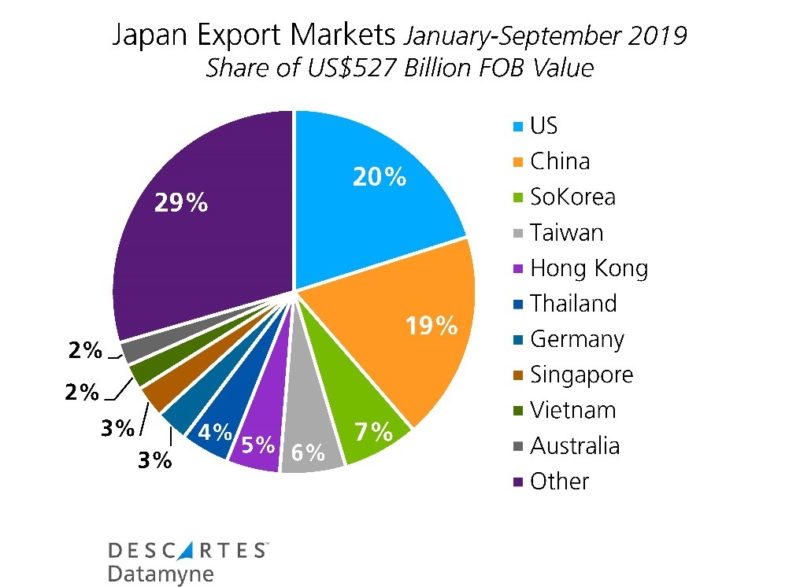
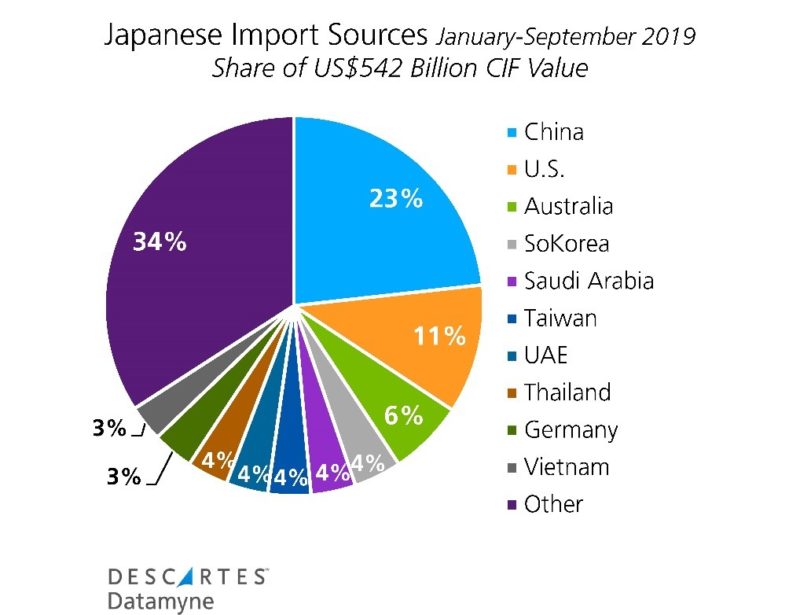
Japan is also a key trade partner for the U.S., consistently ranking fourth behind America’s continental neighbors, Canada and Mexico, and China. Here are the rankings as of the end of September:
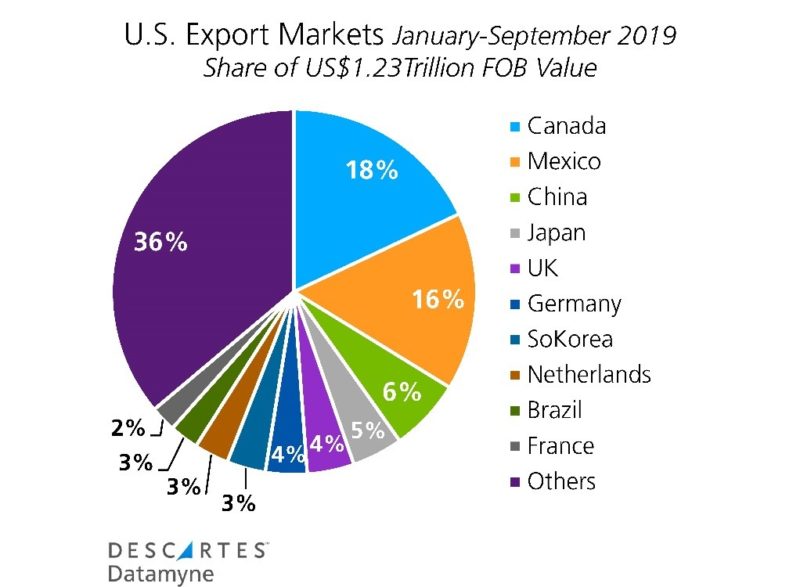
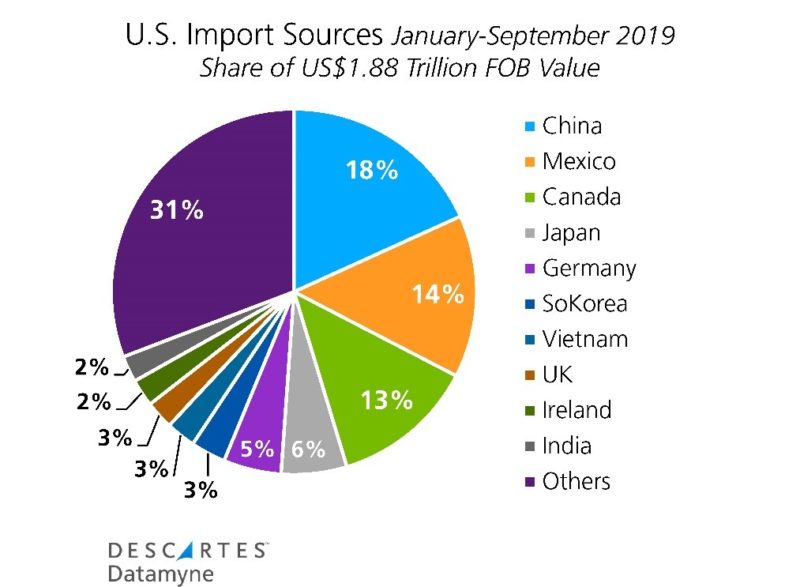
In a year fraught with trade tensions, progress toward a U.S.-Japan FTA is a welcome change of pace. Still, there are issues to be resolved. A top-of-agenda item for Japan is revealed by our U.S. import data:
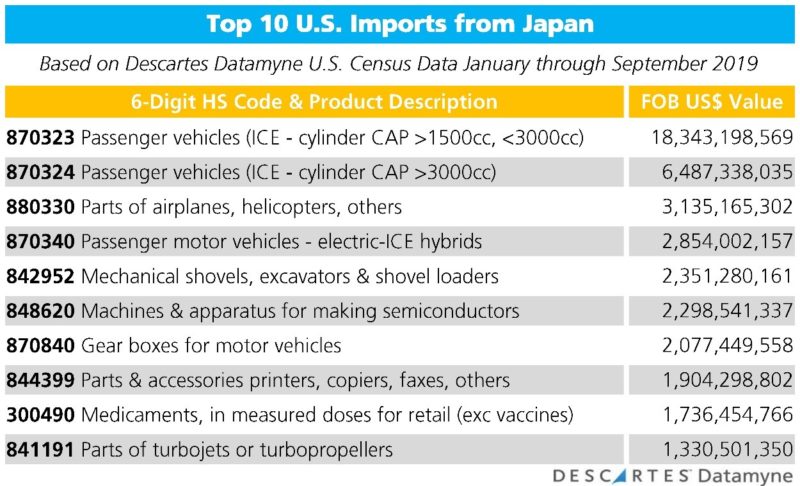
Automobiles dominate Japan’s sales to the U.S. – with internal combustion engine (ICE) vehicles ranked first and second by value of trade and hybrid electric vehicles (EVs) fourth. The broad category of passenger motor vehicles (HS8708) accounted for 27% of all U.S. imports from Japan in 2019 through the third quarter.
With so much at stake, Japan has been eager to secure an exemption from the tariffs on imported cars that the U.S. has been weighing for the past year.
The tariffs in question address a potential risk to U.S. national security, determined by the Commerce Department in 2018, as authorized under Section 232 of the Trade Expansion Act of 1962. They have been and look likely to remain a contentious issue in U.S. relations with trade partners in North America and the EU as well as Japan: November 13, the latest of several postponed deadlines on deciding whether to impose the tariffs, has slipped by without any action from the Trump administration.
The partial deal between the U.S. and Japan does not include a formal commitment from Washington, sought by Tokyo, to spare Japanese automobiles from Section 232 tariffs. However, Japan did receive assurances that its automotive products are not candidates for increased duties.
In addition, the U.S. agreed to reduce or eliminate tariffs on Japanese 42 agricultural products, representing a total import value of $40 million in 2018, and including certain perennial plants, cut flowers, persimmons, green tea, chewing gum, and soy sauce. The U.S. will also lower or eliminate duties on a list of Japanese industrial goods that includes machine tools, fasteners, steam turbines, bicycles, bicycle parts, and musical instruments.
U.S.-Japan Trade Talks Yield a Win for U.S. Agricultural Exports
For its part, Japan will immediately end tariffs on U.S. almonds, walnuts, blueberries, cranberries, sweet corn, broccoli, and grain sorghum, among other agricultural products. Tariffs on fresh and frozen beef and pork will be reduced, as will the mark-up on U.S. wheat and barley.
Japan will also initiate a phase-out of tariffs on a range of agricultural products, including cheeses, processed pork, poultry, beef offal, ethanol, wine, frozen potatoes, oranges, fresh cherries, egg products, and tomato paste.
These are important gains in a critical market for U.S. agricultural exports. While the top U.S. exports to Japan by value are dominated by higher-price aviation and energy products, two agricultural exports manage to make the top 10, corn and beef. The next table summarizes the ranking data:
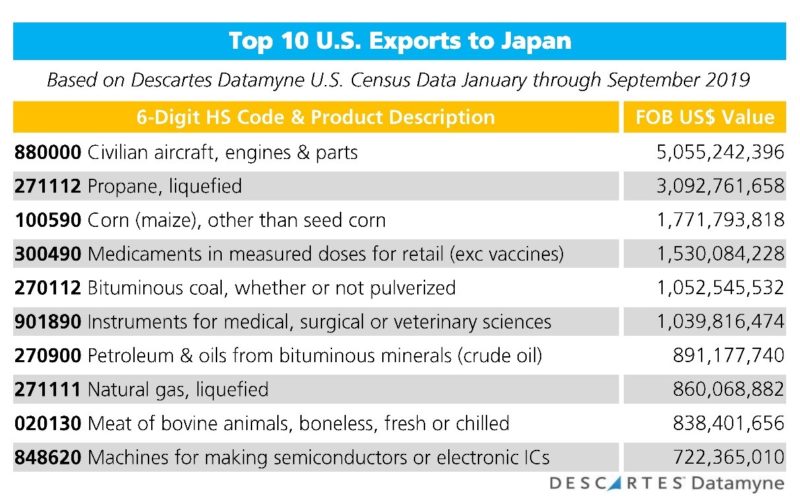
Narrowing the focus to U.S. agricultural exports confirms Japan’s leadership as a destination for U.S. agricultural output. While Japan has been U.S. agriculture’s fourth biggest export market historically, in 2018 it ranked third behind Canada and Mexico – and first among overseas markets:
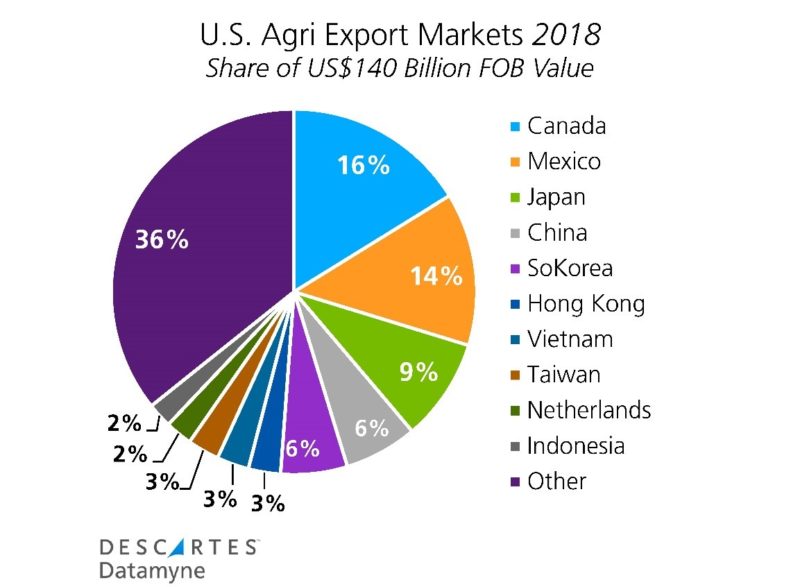
Note that the pie chart is based on data for the HS codes followed by the US Dept. of Agriculture and covers the most recent calendar year – during which U.S. agri exports bore the brunt of China’s retaliatory moves in the U.S.-China trade war.
U.S. grain sorghum exports, for instance, fell 22% between 2017 and 2018, with shipments to China falling 37%.
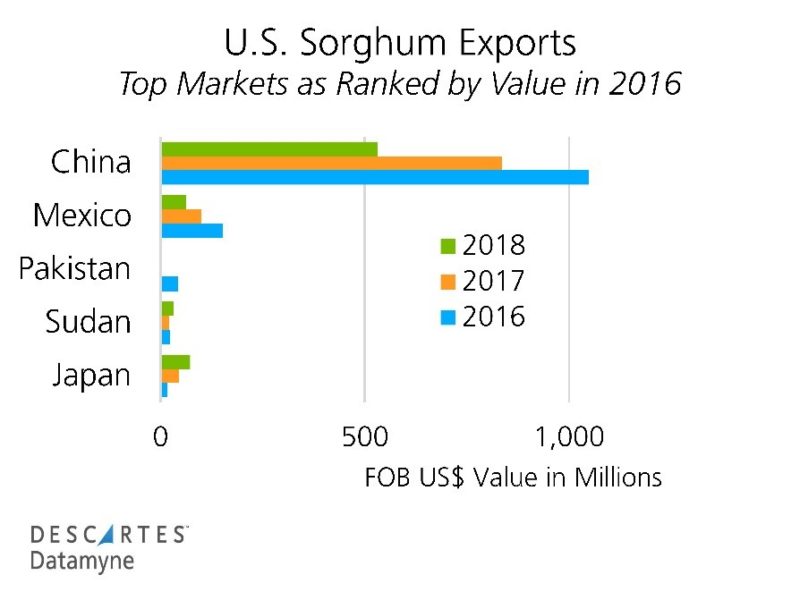
Similarly, U.S. soybean exports have been a casualty of trade war, declining 21% year-over-year in 2018 as China slashed purchases by 75%.

By the end of 2018, Japan had moved up to become the (admittedly distant) second biggest destination for U.S. sorghum, but slipped to fifth among markets for U.S. soybeans. As the graphs make plain, the U.S. will not soon recoup its Chinese export losses in the Japanese or any other single market alone. But the partial deal between the U.S. and Japan is an important competitive market move, welcomed by the agricultural sector.
In a joint letter to the House Ways and Means Committee, some 30 food and agricultural associations explain why it is critical to leverage the existing U.S. trade relationship with Japan right now. The Comprehensive and Progressive Trans-Pacific Partnership Agreement (CP-TPP), which entered into force for Japan along with Australia, Canada, New Zealand, and Singapore last December, reduces tariffs and other constraints on imports from countries vying with the U.S. for global market share.
September’s phase-one agreement will help level the competitive field, assuring that Japan extends similar tariff treatment to U.S. exporters. It is also an important step forward, adding momentum, it is hoped, to phase-two negotiations on more market access and non-tariff measures, including sanitary and phyto-sanitary protocols, to achieve a comprehensive trade agreement.
Related:
Blog Coverage:
- The Broad-Gauge Impact of Section 232 Tariffs on Steel and Aluminum
- Car Alarm: U.S. Auto Exports & The Impact of Shifting Trade Policy
Solutions and Resources:
- Temporary tariffs and quotas such as those imposed by the U.S. under Section 232 are increasingly being used not only to resolve trade disputes, but as bargaining chips in trade negotiations. For businesses that operate internationally, the scope and pace of changes to Customs requirements can be bewildering. Descartes CustomsInfoTMManager offers a practical solution with end-to-end enterprise software for up-to-date tariff classifications. Learn more >>
- Rapidly evolving trade policy and tariff instability are causing headaches for supply chain managers. Our Tariff Engineering Podcastdiscusses ways to restructure the chain to reclarify products and mitigate duty spend. Go to the podcast >>
- Take a closer look at the effects of the China-U.S. trade war and strategies to diversify supply chains to moderate risks and boost resilience in our White Paper: Targeting New Opportunities Amid Shifting Trade Policy the Sourcing and Diversification. Download the white paper >>



